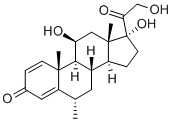83-43-2

SAFETY INFORMATION
| Signal word | Danger |
|---|---|
| Pictogram(s) |
 Health Hazard GHS08 |
| GHS Hazard Statements |
H373:Specific target organ toxicity, repeated exposure |
| Precautionary Statement Codes |
P202:Do not handle until all safety precautions have been read and understood. P260:Do not breathe dust/fume/gas/mist/vapours/spray. P280:Wear protective gloves/protective clothing/eye protection/face protection. P308+P313:IF exposed or concerned: Get medical advice/attention. P405:Store locked up. P501:Dispose of contents/container to..… |
PRODUCT INTRODUCTION
Description
Methylprednisolone (MP) is a potent synthetic glucocorticoid capable of up-regulating anti-inflammatory factors and promoting the survival of cells by decreasing oxidative stress. In animal models of SCI, there are strong data showing a reduction in tissue loss and improvements in functional recovery with treatment. It became popular after promising results in two National Acute Spinal Cord Injury Studies (NASCIS) clinical trials. In clinical trial III, it was established that MP was only effective if administered 3–8 h after the time of injury, and treatment was maintained for either 24 h (if MP was administered within 3 h) or 48 h (if MP was administered between 3 and 8 h) respectively. It was first hypothesized that MP's mechanism of action was through the maintenance of the vascular integrity at the site of injury. More investigation into the neuroprotective effects of MP led to the belief that the therapeutic effect of MP was through (1) enhancing the excitability and conduction of neurons, (2) improving blood supply, and (3) reducing lipid peroxidation caused by free radicals.
